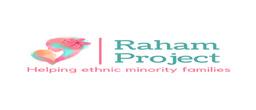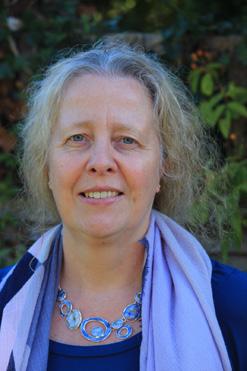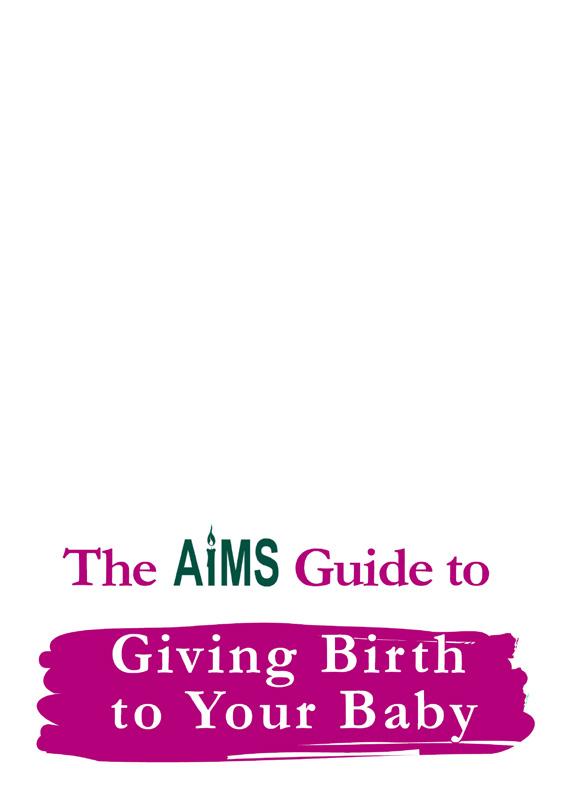
13 minute read
Interview with Sarah Fishburn
from AIMS Journal Vol 34 No 1 Induction: Love's labours lost
by AIMS (Association for Improvements in the Maternity Services)
to understand and when key themes are suggested by people, we then take them further to create informative videos. We have begun to focus on creating videos in Mirpuri, a language understood by most people within our local Pakistani community.
Finally, we offer monthly listening sessions. This is where we hold online monthly events to listen to people that connect with us; we then use their voices and stories collectively to give feedback to our Cambridgeshire and Peterborough Local Maternity and Neonatal System. These stories are shared within a safe space of trusted women. If people wish to have a one-to-one conversation, we offer this on a case-to-case basis. Over time, we have developed a small voluntary online peer support group led by mothers from diverse ethnic backgrounds for mothers that identify with them.
Advertisement
Raham project continues to develop and support families from ethnic minority backgrounds. We are developing links with other charities such as Cambridgeshire, Peterborough and South Lincolnshire Mind and Barnardos. We’re looking forward to creating a partnership project of a central hub space for minority ethnic women local to Peterborough.
These are early but exciting days. We are currently based in a small city, but the power of social media has provided us with access to people from other places and there is scope for us to grow all across the UK.
We have and will continue to be the voice of those who either need to be heard or want to strive for change, a change that will require a whole community.
Author Bio: Faiza Rehman was born and raised in the U.K. in a tight knit south Asian family. She is the mother of two young children and a qualified midwife, who has been practising since 2011. She comments, “I am hugely passionate about all things midwifery and ensuring we care for families so they emerge from their birth both physically and emotionally safe. This passion has driven me to start a grassroots organisation: Raham Project, a platform to support families from diverse ethnic backgrounds”.
1 MBRRACE-UK Saving Lives, Improving Mothers' Care 2017-19, November 2021 2 MBRRACE-UK Perinatal Mortality Surveillance Report for births in 2019, October 2021
Campaigns
Interview with Sarah Fishburn
Interview by Jo Dagustun

Many different organisations and individuals play a part in the mission to improve UK maternity services for all. In this interview, the AIMS Campaigns Team talks to Sarah Fishburn, a maternity improvement campaigner who was inspired to get involved following her own maternity service user experiences, and who is now - amongst other roles - the chair of the NICE Multiple Obstetric Guidelines Update Committee. This committee oversees the development and updating of many NICE guidelines of relevance to the maternity service. We hope that our readers will be inspired to read about the way in which Sarah - starting as a ‘mere’ service user! - has demonstrated a long-standing commitment to improving maternity services. Thank you for agreeing to be interviewed by AIMS, Sarah. To start, can you tell us about what drives your interest in a wellfunctioning maternity service, and how you got started? Thanks very much for inviting me Jo, it’s a pleasure to take part.
I became interested in improving maternity services after having my first baby. During my pregnancy I was reassured that having difficulty walking and generally moving around, due to pain in my pelvic joints and a feeling that my pelvis
was unstable when I tried to move, was completely normal. I was told it would get better as soon as I had my baby and not to worry because the baby was fine. I went on to have a forceps birth and afterwards was completely unable to walk, but was again reassured that this was normal and this was what having a baby was like. I should just get on with it. Physios told me to exercise more, rest more, lose weight, push the pram – none of these things were possible with a painful pelvis and a small baby. This went on for weeks, which turned into months, during which time I met lots of other mums with similar problems. It felt like nobody else was listening and life was pretty grim. Eventually, after my baby was a year old, a friend told me about a sports physio who was good at treating pelvises. She did a simple assessment putting her hands on my pelvic joints, and actually looked at and felt how my pelvic joints moved. She found that one of them was a bit stuck and got it moving again, all in a half hour session. I could immediately walk a bit better, and continued to improve with the treatment that followed.
I felt very let down realising that this treatment could have started during my pregnancy had I been listened to, and I started to get involved with the local Maternity Service Liaison Committee (MSLC), and remained with them for 13 years until they were stopped during a reorganisation.
I was also meeting an increasing number of women with pelvic girdle pain (PGP), which, it transpired, was why I couldn’t walk. This used to be known as Symphysis Pubis Dysfunction, but the name changed in the UK in 2008 when we developed a new national guideline alongside the Pelvic, Obstetric and Gynaecological Physiotherapy (POGP) group. In 2002, a previous national support group closed, and local friends in Oxfordshire were keen to set up a replacement group as we were struggling to access treatment locally. The Pelvic Partnership was formed, and became a registered charity in 2003. The charity is one of the achievements I am most proud of in my life. We provide information and support to women with PGP, and have a proactive approach to encouraging women to seek treatment (the word “suffering” is banned as we think implies that women are passive recipients of care, rather than individuals who should make choices and say when things are not getting better). Our emphasis is on women ‘experiencing PGP’, a condition that you will recover from, as most women do when they access good quality manual therapy treatment.
I chair the charity, answering the telephone helpline, and leading the amazing team of trustees who support women and health professionals, develop information leaflets and website content, and run the Instagram and Facebook support networks, fired by the enthusiasm and skill of Jen, our coordinator.
The MSLC network gave me an insight into the opportunities that were evolving for service user involvement, first auditing with the Local Supervising Authority, then with the Nursing and Midwifery Council.
I also heard about the opportunity to be part of the committee developing the NICE guideline for socially complex pregnancy where I was one of two lay members. I loved the systematic way that the evidence was reviewed, the way that all the members of the committee were viewed as equal, and also came to understand that there are not simple research answers to all questions, and that there are some really sticky questions that require in depth committee discussion to find an answer, which may not be perfect but is the best you can do. I also liked the focus on women’s choice, and I think this element has been strengthened throughout my involvement with NICE. Can you tell me a bit about your day job? My interest in maternity care and NICE guidance led me to take a role within the former Clinical Networks, part of NHS England, where I led a project to measure implementation of the NICE Quality Standard for Antenatal and Postnatal Mental Health across the south of England. This was a fascinating project linking midwives, health visitors and various mental health services for pregnant and postnatal women, and measuring how well they were implementing the standards, and supporting quality improvement activities as a result. This role changed during COVID-19 when I spent some time supporting the homeless health team and an investigation team, and I’m currently on an exciting secondment with the quality improvement team.
I enjoy variety in my work, and I have a particular interest in keeping service-user experience at the heart of everything I do. This is one of the key elements of quality that we discuss every day. The combination of safety
(was the episode safe?), outcome (was the outcome of the episode/intervention successful?) and experience (did the person and their family have a positive experience of care?) are inextricably linked to make up good quality care.
You currently hold the role of chair of the NICE Multiple Obstetric Guidelines Update Guideline Committee. AIMS is clear that NICE is a key element of an effective maternity service infrastructure, so we thank you for this work. But for many people, the role of NICE and its internal workings are rather murky. Can you say a bit more about this role, what you bring to it, and what are the essential qualities of an effective NICE committee lay member? I am very proud to be chairing this NICE committee. It has been enormously rewarding and has also had its challenges during COVID-19. Chairing all-day committees online, and making sure everyone stays connected, is very different from chairing a room full of people, but the fantastic team at the National Guideline Alliance, which hosts this particular guideline, are very experienced and support the whole process.
People sometimes think that NICE processes are rather opaque, but I think that the complexity of what they achieve is astounding, and there is a huge amount of information available on the website www.nice.org.uk that explains the processes.
One of the key strengths of the development process is the involvement of both stakeholders and lay members in all guideline development activity. Most of the updates we are currently working on have been identified by stakeholders who have contacted NICE (anyone can do this by contacting surveillance@nice.org.uk).
Stakeholder comment shapes the final wording enormously and we are really grateful to everyone who takes the time to suggest improvements to our draft guidance. There are often times when the research evidence is not as robust as we would like, and we have to use committee expertise to add detail to the recommendations. We then welcome stakeholders who tell us whether they do or do not like what we have developed (and why) as part of the consultation phase of the guideline’s development. AIMS devotes much of its precious Volunteer time to reviewing and commenting on draft NICE guidelines. Do you agree that this should be a priority for AIMS, and what are your tips on how we - and our colleagues across the maternity services improvement community - could be more effective in this work? I think AIMS does a great job reviewing and commenting on NICE guidelines. I know how time-consuming it can be reading the guidance and conferring with others on the response, and the turnaround times can seem quite short. Every comment that is submitted is read and receives a response from the committee, and we really appreciate the work that has gone into the comments.
Without stakeholder review and comment, the guidelines would be less robust, and would be less useful as a result, both for clinicians and for women and families making decisions about care. The guidelines are for both groups. I think one of the great strengths of the NICE guidance development process is the involvement of lay members right from the scoping stage, through development and into the consultation and post-consultation phases. It influences the focus, the language and the final use of guidance as a working document in practice. The fact that it is publicly freely available means it should be accessible to anyone who wishes to read or use the information in the UK.
The NICE guideline development work on inducing labour has been a hot topic across the maternity services improvement community, perhaps most infamously for the - now dropped - draft recommendation to offer induction on the basis of race/ ethnicity. How can we ensure that all NICE recommendations are evidence-based?
Evidence comes in a variety of forms. Gold standard evidence in the form of randomised control trials is ideally what we want to base our guideline recommendations on. The MBRRACE-UK Maternal Report 2021 and other research shows that women from Black and Asian backgrounds have a higher risk of dying for both the women and their babies. NICE publishes draft guidelines in order to ensure they are robust, and the consultation period allows feedback from anyone interested in the topic. This really does make sure we produce the best guidelines possible both for service users and professionals. The stakeholder response to the draft guideline was very helpful in raising the profile of this difference in outcomes, along with the need for increased focus on discussing decisions and choices with women and supporting these choices. I think the finished guideline reflected the strong and constructive stakeholder response and helped us to produce a better guideline.
Would you like to tell us a little about the #ReadyForPregnancy project that you’ve been working on? This South East of England project started as a social media campaign, focussing on reducing inequalities by sharing information about ways that women and their families could take action to begin their pregnancy healthier, in order to improve outcomes for women and their babies. This project became much bigger than we had anticipated and, as part of our regional equalities impact assessment, we identified a need for materials translated into languages other than English, as well as materials for families who were visually impaired or deaf. We included video clips from women talking about their experiences. We developed a downloadable and printable leaflet, which we translated into the 10 most common languages in the South East of England, along with a subtitled video with British Sign Language translation.
Following the success of this campaign, we’re now running a #ReadyforParenthood campaign using the same principles, and we’re starting work on additional materials as the campaign progresses – please look out for it and join in.
What do you think is the biggest challenge faced in maternity service improvement work in the UK today? I think in the current COVID situation, the key challenge is workforce. I have a concern that the tremendously positive emphasis on providing person-centred care is at risk of being lost in the complexity of providing COVID-secure care with fewer people providing the care. I hope that one of the things that will emerge from the pandemic is an increase in the workforce, who will all have been educated to use recent, evidence-based and person-focused practice. AIMS celebrated its 60th birthday in 2020. Looking forward, how do you think AIMS might best focus our limited resources, to help ensure improved maternity services for all? I think AIMS does a great job of focusing on understanding and sharing the views of parents, and standing up for these. By continuing to share the combined knowledge and experience of so many thoughtful and well-informed people, and horizon-scanning for areas where evidence and practice diverge, AIMS can continue to keep parents at the centre of the focus of care, which I think is where they should be. Your body’s physiology is in the spotlight in this book.

The AIMS Guide to Giving Birth to Your Baby focuses on the second and third phase of the birth process: from your cervix reaching full dilation and your baby descending through your pelvis, to the final stage when your baby is born.
You will learn about the supportive role of hormones, about how to use your body’s powers and your instinct and emotions to help your baby negotiate his or her way into the world.
Available in paperback (£8) and kindle format from the AIMS shop
www.aims.org.uk/shop







